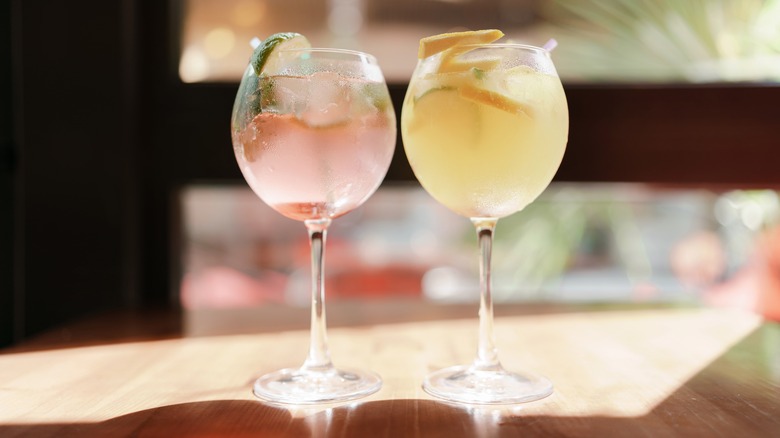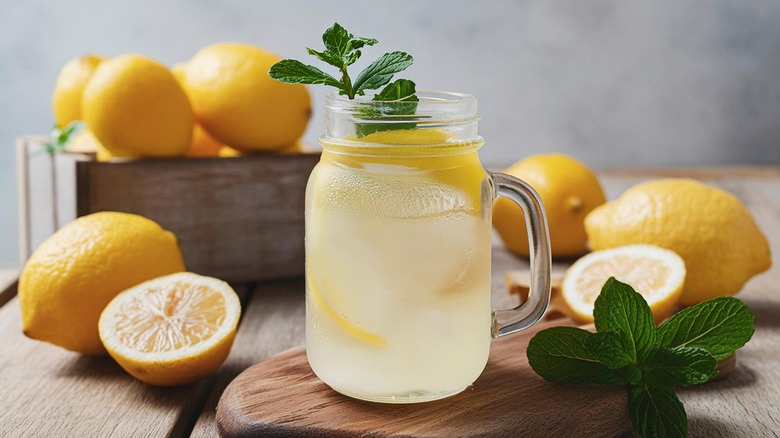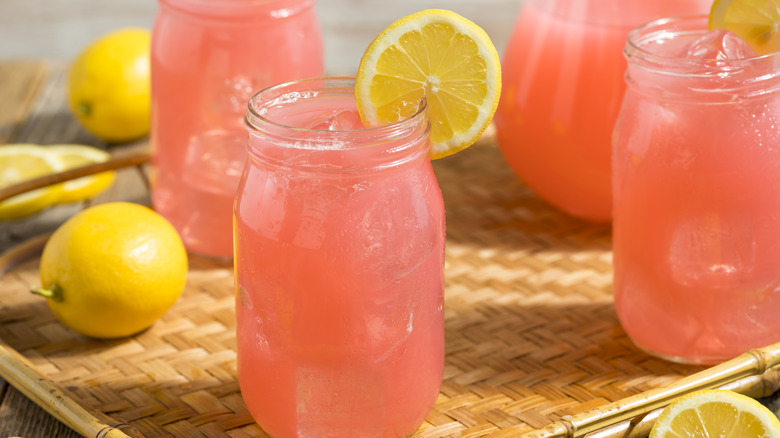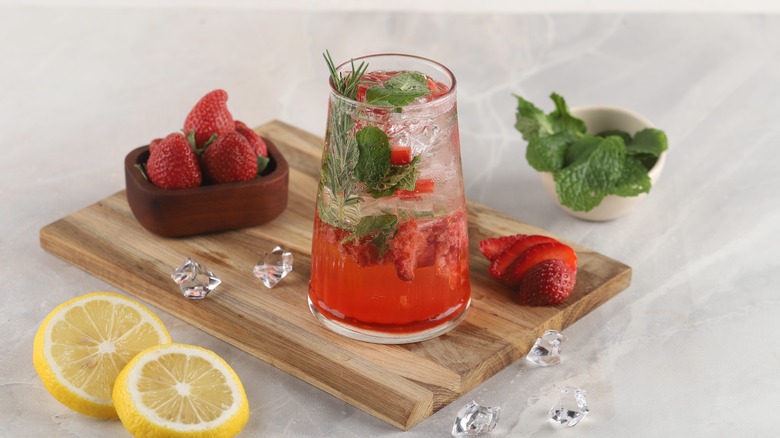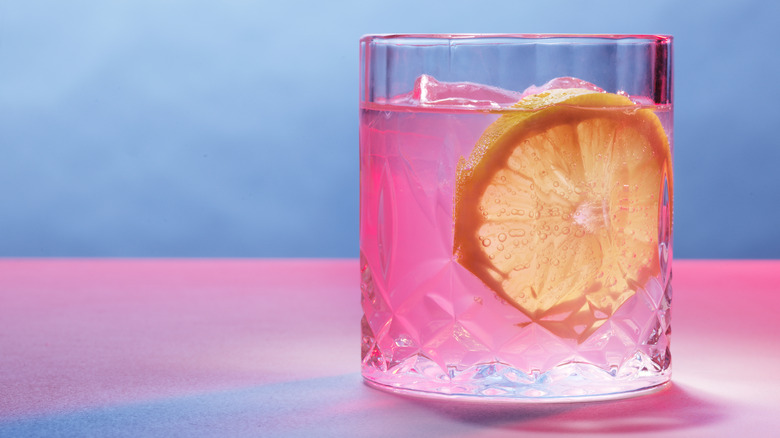Pink Lemonade Vs Lemonade: Is There Really A Difference In Flavor?
There's nothing more refreshing than an ice-cold glass of lemonade on a hot summer day, except, perhaps, a gorgeous glass of pink lemonade, its colorful cousin. It's true that lemonade, with its mouthwatering tartness, leaves us feeling more hydrated for longer than plain water, but does pink lemonade's bright hue add extra thirst-quenching oomph to the equation?
If you've ever sipped this vaguely-named beverage you've probably wondered exactly what made it pink. Yes, it tastes like lemonade, but it also tastes a little bit like something else ... or does it? Well, you don't need to wonder any longer — here's everything you've ever wanted to know about the difference between lemonade and pink lemonade, including how it's made and whether it actually tastes different at all.
What is lemonade?
Lemonade, a summertime staple, is the very definition of simplicity. Most lemonade recipes start with one part sugar (often in the form of a simple syrup) to one part lemon juice mixed into anywhere from one to seven parts water, depending on how intense you want the flavor to be. But people in different parts of the world enjoy lemonade differently. Turkish lemonade uses the entire lemon, pith and all, which is grated and rubbed into the sugar, added at the end as a fresh garnish, or boiled into a simple syrup. In Paris, lemonade is served fully deconstructed with separate containers of lemon juice, water, and simple syrup that everyone mixes to taste for themselves at the table. And in North Africa and Portugal, lemonade is enjoyed with cold brew coffee.
This quintessential combination is more than classic — it's ancient. In 10th century Egypt, records describe a beverage known as qatarmizat, which was made with lemon juice and sugar. In the 1600s, Parisian vendors sold lemonade made with carbonated water from tanks they carried through the streets like backpacks. The beverage was so popular that peels filled the streets, where the limonene in the discarded peels poisoned fleas and stopped the raging bubonic plague. The earliest American lemonade recipes were more dessert than beverage, mixed with raw egg whites and frozen or whipped, but by the mid-1800s lemonade had become a hot (or, rather, cold) commodity at circuses and fairs.
What is pink lemonade?
Pink lemonade is exactly what it sounds like — lemonade that has been tinted pink. Some commercial pink lemonades, like those sold in a jug or powdered mix at the grocery store, are just lemonade with red food dye added. But most homemade pink lemonade recipes add a little extra flavor along with that gorgeous ruby color using syrups (such as grenadine), fruit juices (like cranberry or grape), or fruit purees.
The first pink lemonade was born in the same place where regular lemonade gained popularity in the United States — at the circus — and two men are often credited (one somewhat begrudgingly) with the serendipitous creation of pink lemonade. One legend claims that a concessions vendor ran out of lemonade with a line of thirsty patrons waiting to be served, so he grabbed the first liquid he could find, which happened to be the dirty wash water a performer had used to rinse out her pink stockings. The second (much more appetizing) origin story also comes from the circus, where another vendor accidentally spilled a container of cinnamon candies into his vat of lemonade. He went on to sell it anyway, and his customers went wild for it, so the drink stuck. Today's pink lemonade is usually colored with dye or fruit, not cinnamon, but this concoction was apparently popular for a while, because you can still find spiced lemonade recipes in some old cookbooks.
Pink lemonade is, well, pink
There are really only two conditions that must be true in order to call a beverage "pink lemonade" — it must be lemonade, and it must be pink, and this can be accomplished in a few different ways, some more flavorful than others. But what you use to color your pink lemonade can change the appearance of the drink in other ways, too.
Mixtures of different types of liquids, such as lemonade, tend to separate when left to sit. In regular lemonade, for example, the simple syrup, which is denser than water, tends to sink to the bottom of the container, but because the syrup and water are clear and the lemon juice is a pale, cloudy yellow, it's not usually noticeable. Fruit purees and syrups, on the other hand, are much denser than the lemonade they're mixed with, and because they're so brightly colored, it's visibly apparent when they separate from the lemonade, giving the beverage a lovely gradient, like a sunrise cocktail (or mocktail).
They don't always taste the same
Depending on how it's made, pink lemonade can taste exactly the same as regular lemonade or completely different. Since food dyes are unflavored, if the lemonade is merely tinted pink with food coloring, it will taste exactly like the lemonade base used. Well, maybe not quite exactly the same — studies show that people associate pink and red with sweetness, so it might taste sweeter, even if it's not. But since some pink lemonades get their characteristic coloring from red syrups, fruit juices, and fruit purees, the flavor can vary as dramatically as the hue.
Of course, the exact flavor profile of any pink lemonade will depend on the syrups, juices, or fruits used to color it. Concentrated fruit syrups like grenadine, strawberry, or cherry can add an intense pop of fruit flavor, depending on how much you use, plus a lot of extra sweetness. Juices like cranberry and grape, on the other hand, add a subtler fruitiness to the lemonade, while fruit purees add texture as well as flavor. Pink lemonade tinted with syrups, juices, or purees also tends to be less tart than regular lemonade because the sweetness of the additives balances the intense sourness of the lemons.
